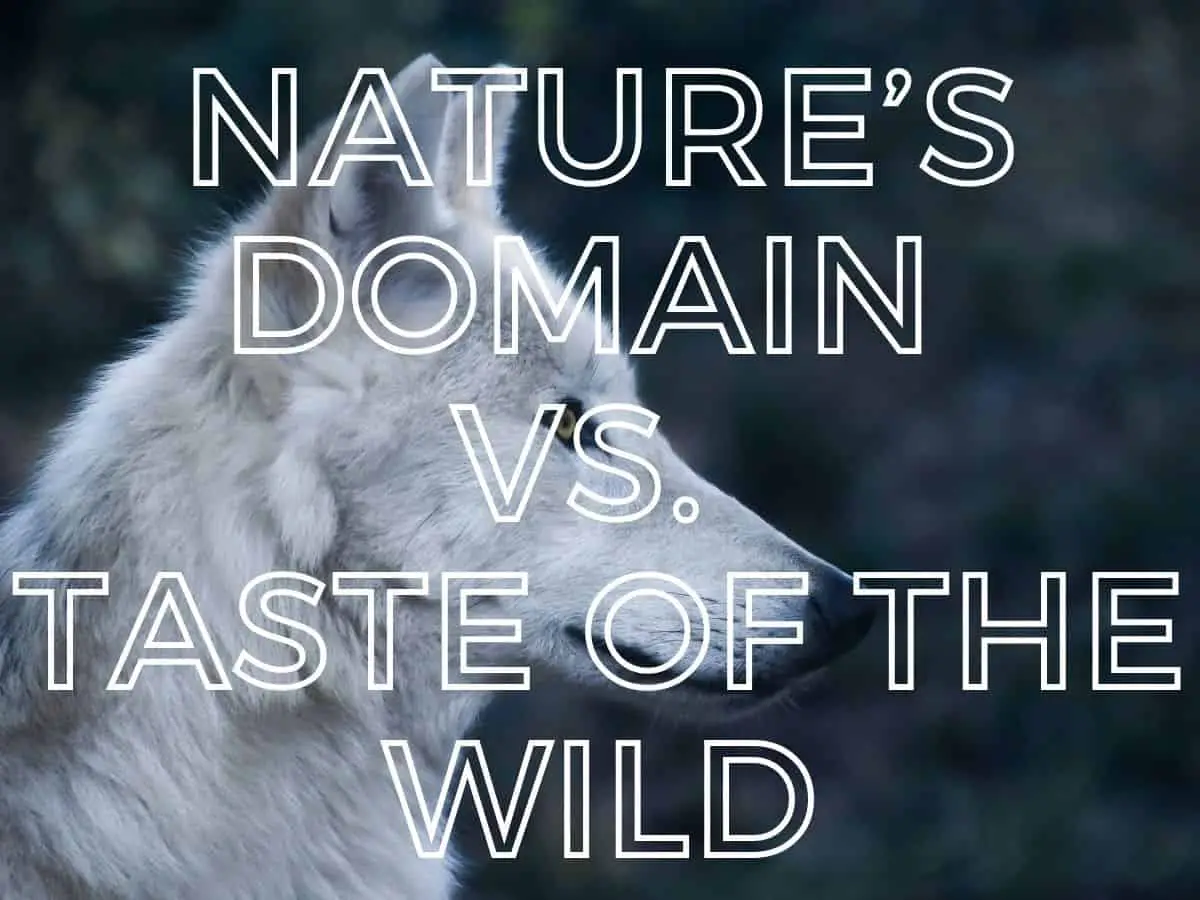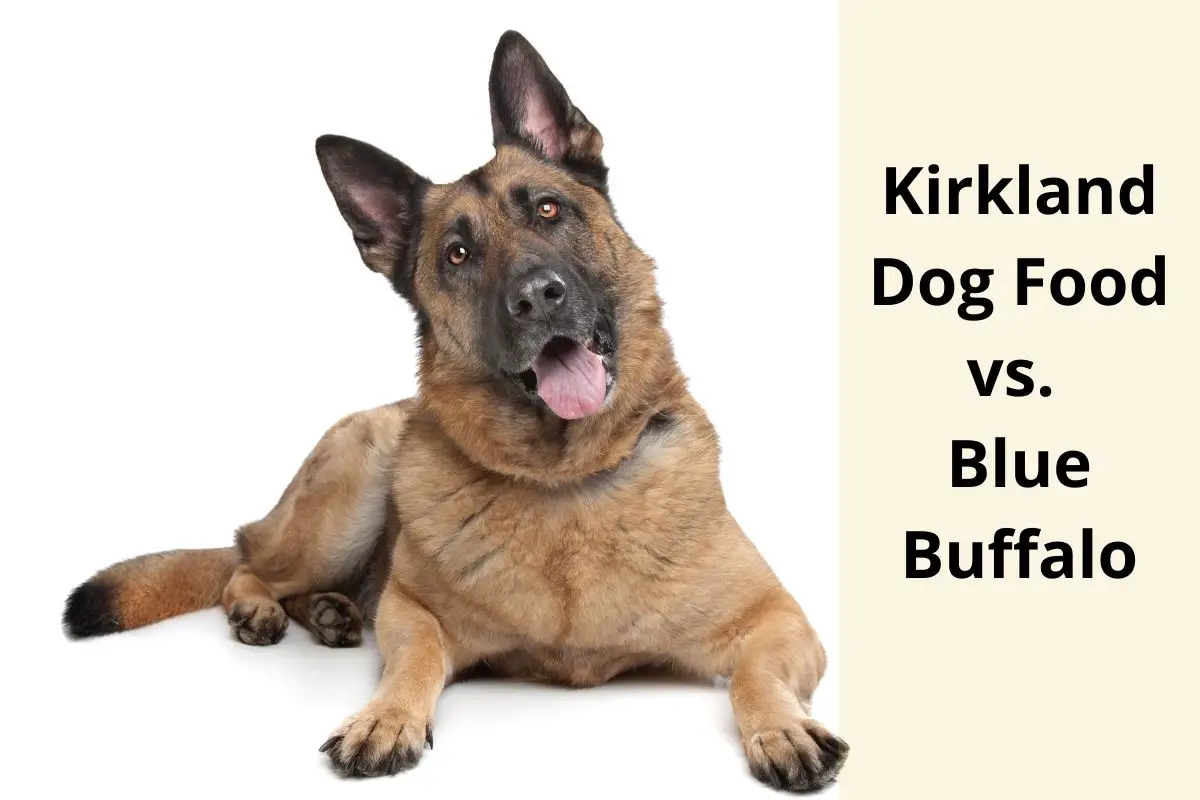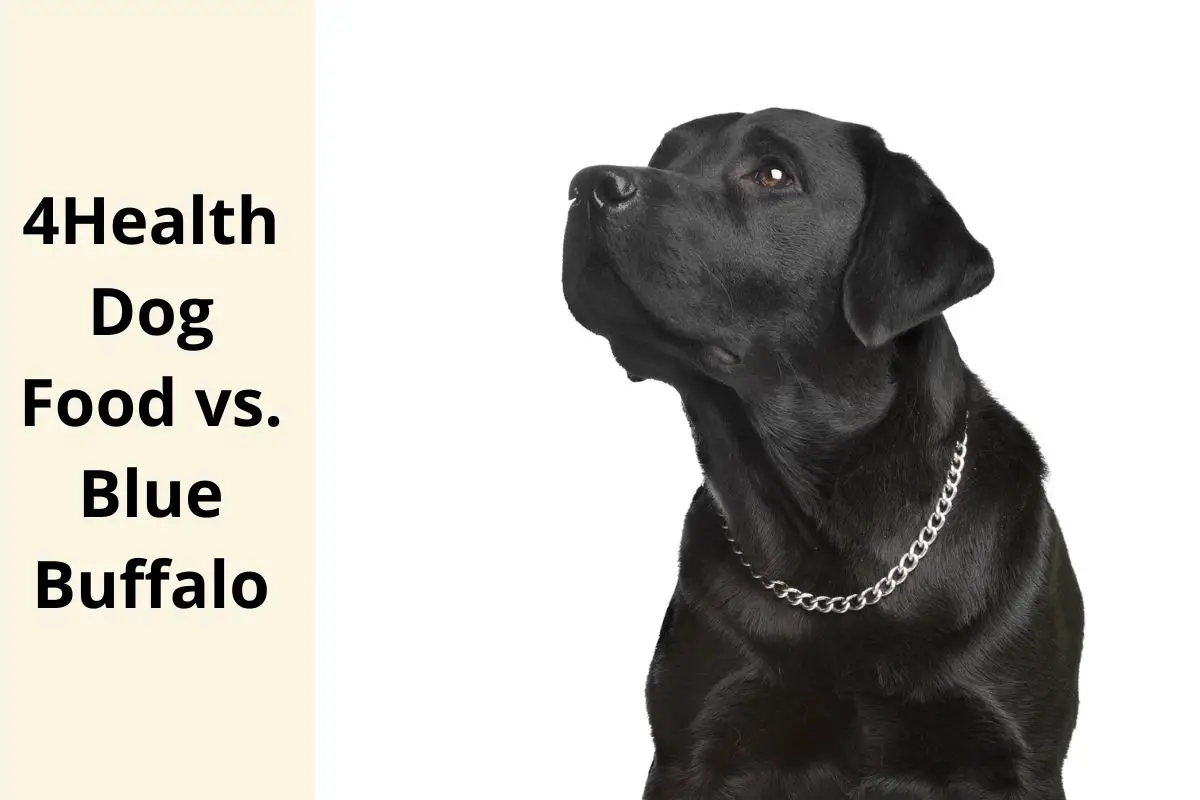This post contains affiliate links.
Every dog owner’s priority is ensuring the health and well being of their furry friend, and finding the right dog food is an essential part of keeping your dog happy. With dozens of brands on the market, choosing a dog food that is both delicious and nutritious can be a daunting task, but with this guide, you will learn the pros and cons of two leading brands: Nature’s Domain and Taste of the Wild.
Nature’s Domain and Taste of the Wild both have their pros and cons. Nature’s Domain is a little more affordable, although you need a Costco Membership for purchases, while Taste of the Wild is a bit pricier but uses more animal proteins in recipes with fewer ingredients.
In this article, we will take a look at the different reasons why both of these dog foods are some of the most popular brands on the market. By comparing recipes and providing a detailed breakdown of each brand’s ingredients, we will help you choose the right food for your dog. If you ever wondered how these brands stack up against each other, read on.
Table of Contents
Basic Similarities
Before we jump into the specifics of each of these brands, let’s take a look at some of the similarities between pet foods produced by Nature’s Domain and Taste of the Wild.
Both of these dry dog food brands use grain-free recipes, an essential feature for pet owners who have dogs with grain allergies. The high carbohydrate content in grains can also contribute to obesity in some dogs. Recently, Taste of the Wild has released several limited grain content recipes for dog’s that require added carbs in their diets.
Most of the recipes offered by both brands also incorporate Yucca Schidigera extract, a product that has been shown to reduce the foul odor of dog food waste; an additional ingredient that most dog owners can appreciate.
Nature’s Domain and Taste of the Wild are also both produced in the United States by the same manufacturer, Diamond Pet Foods, and almost all of these products meet the American Association of Feed Control Officials dog food nutrient profiles.
Nature’s Domain and Taste of the Wild were also both part of a national recall in 2012 that we will examine at the end of the article.
Let’s take a closer look at some of the most popular products that each of these brands produces, starting with Nature’s Domain.
Nature’s Domain Pros & Cons
|
Pros |
Cons |
|
Grain-Free Recipes |
Recall History |
|
Reasonable Pricing |
Limited Product Line |
|
Manufactured in the U.S.A. |
Costco Membership Required |
Nature’s Domain is wholesale retailer Costco’s store brand, and unlike Taste of the Wild, it only produces a handful of different dog food recipes. The Costco connection is worth mentioning because, to purchase Nature’s Domain, dog owners will need a Costco Membership card or be willing to pay an additional 5% fee when purchasing this brand online.
While the limited availability may be a deal breaker for non-members, for the thousands of Costco shoppers, having a quality store brand makes this an appealing, convenient and affordable choice.
As we mentioned, Costco doesn’t produce this product themselves, instead, leaving the manufacturing side of the process to U.S. based Diamond Pet Foods. While the food is processed domestically, Diamond Pet Foods uses both U.S.-sourced and internationally imported ingredients.
Nature’s Domain Salmon Meal and Sweet Potato
|
Pros |
Cons |
|
Grain-Free |
Costco Membership Required |
|
High-Protein Salmon Meal |
Contains Pea Protein |
|
Contains Omega Fatty Acids |
Contains Canola Oil |
|
Contains Antioxidants | |
|
Meets AAFCO All Stage Nutritional Requirements |
Nutritional Information
- Carbohydrates: 49%
- Protein: 24%
- Fat: 14%
- Fiber: 3%
- Moisture: 10%
Key Ingredients
Salmon meal, sweet potatoes, peas, potatoes, canola oil, ocean fish meal, pea protein, potato fiber, natural flavor, flaxseed, salt, choline chloride, dried chicory root, tomatoes, blueberries, raspberries, Yucca Schidigera extract
One of their more popular products, the first ingredient in this recipe is salmon meal, a processed meat concentrate that has a much higher protein percentage than fresh salmon thanks to the rendering process. Salmon also provides valuable omega fatty acids that are essential for your dog’s health.
Also, on the pro side, this is a grain-free recipe that many owners prefer to keep their dogs lean and healthy.
Recognized by the AAFCO and meeting their standards for All Life Stages, the naturally occurring antioxidants, Vitamin E and selenium all help to keep your dog happy and fit.
The main cons of this product are the inclusion of pea protein and canola oil.
- Pea protein is often used as a way to skew the protein content of dog food. While this is not always the case, pea protein is not as bioavailable or high in amino acids as meat-based proteins.
- This product also contains canola oil, a controversial ingredient that some feel is an unnecessary addition to dog food.
The other factor that may turn some dog owners away is the fact that this product is exclusively sold at Costco stores, barring some online outlets that charge an additional fee for non-members.
Nature’s Domain Puppy Chicken & Pea
|
Pros |
Cons |
|
Grain-Free Recipe |
Unspecified by AAFCO |
|
Contains Salmon Oil for Omega Fatty Acids |
Limited Availability |
|
Small Kibble for Puppies |
Contains Tomato Pomace |
|
Contains Antioxidants | |
|
High-Protein Chicken |
Nutritional Information
- Carbohydrates: 43.5%
- Protein: 27%
- Fat: 15%
- Fiber: 4.5%
- Moisture: 10%
Key Ingredients
Chicken, chicken meal, peas, garbanzo beans, lentils, fava beans, sweet potatoes, chicken fat (preserved with mixed tocopherols), egg product, flaxseed, tomato pomace, natural flavor, salmon oil (a source of DHA), dicalcium phosphate, salt, choline chloride, dried chicory root, Yucca Schidigera extract
Formulated specifically for puppies and growing dogs as well as pregnant or lactating dogs, the first ingredient in this grain-free recipe is chicken, with chicken meal, peas, and chickpeas providing additional protein as well as carbohydrates.
Added salmon oil provides essential omega fatty acids, and the natural antioxidants, Vitamin E, and selenium all help to promote your puppy’s active lifestyle. The small kibble is also great for puppies and makes feeding time that much easier.
While this is a good option for young puppies, this recipe does have some cons. Unfortunately, this product is listed as Unspecified regarding AAFCO nutritional profiles, whether this is due to lack of testing or another reason is unclear. This recipe also includes tomato pomace, a by-product of producing juices and sauces that many people feel is used as a non-nutritional filler.
Once again, the limited availability of this product may turn some dog owners off, despite the competitive pricing.
Nature’s Domain Organic Formula
|
Pros |
Cons |
|
Certified Organic |
High Carbohydrate Content |
|
Contains Omega Fatty Acids |
Contains Canola Oil and Canola Meal |
|
High-Protein Chicken | |
|
Grain-Free |
Nutritional Information
- Carbohydrates: 50.5%
- Protein: 22%
- Fat: 12%
- Fiber: 5.5%
- Moisture: 10%
Key Ingredients
Organic chicken, organic peas, organic lentils, organic garbanzo beans, organic sweet potatoes, organic potatoes, organic canola oil (preserved with mixed tocopherols), organic sunflower meal, organic canola meal, organic flaxseed, natural flavor, organic pea protein, calcium carbonate, dicalcium phosphate, DL-methionine, choline chloride, organic kelp, vitamin E supplement
Some dog owners want their furry friends to eat the most natural diet possible, and for these folks, Nature’s Domain Organic Formula may be a good option. Another grain-free recipe, this dog food, has organic chicken as its first ingredient. It also incorporates several legumes and lentils as well as organic sweet potatoes for carbs and nutrients.
Omega fatty acids are added to promote healthy skin and fur as well as containing Vitamin E.
Some people feel that the carbohydrate content of this recipe is a bit high, with 50% of the calories coming from carbs. Other reviews also put forth the possibility that the recipe may be high in less bioavailable plant protein thanks to the addition of pea protein. Once again, the controversial canola oil is present as well as canola meal, a fact that some owners may not appreciate.
Taste of the Wild Pros & Cons
|
Pros |
Cons |
|
Made in the U.S.A. |
Recall History |
|
Grain-Free Recipes (some grain options are now available) | |
|
Large Variety of Products and Recipes | |
|
Widely Available | |
|
Competitive Pricing |
Taste of the Wild produces a wide variety of dog foods that emphasize their commitment to limited ingredient recipes. They also use natural habitats for recipe inspiration and incorporate a unique mix of different protein sources. The brand stands out for the variety and eclectic animal-based protein sources they incorporate: duck, quail, bison and venison are all used in different Taste of the Wild recipes.
Another appealing feature of Taste of the Wild is the availability. Unlike Nature’s Domain, it can be found at many pet food suppliers and online outlets, making it a convenient choice. While it is slightly more expensive than Nature’s Domain, the higher percentage of animal-based proteins and variety of recipes make Taste of the Wild a popular choice for discerning dog owners.
However, it is produced by the same manufacturer as Nature’s Domain and uses the same blend of domestic and imported ingredients, which explains their shared recall history.
Next, we will take a look at three of their most popular dog food options.
Taste of the Wild High Prairie Canine Recipe
|
Pros |
Cons |
|
Multiple Animal-based Proteins |
Contains Plant Proteins |
|
Contains Omega Fatty Acids | |
|
Contains an assortment of vitamins and minerals | |
|
Contains Probiotics to aid in digestion and gut health | |
|
Grain-Free | |
|
Meets AAFCO Requirements for Adult Maintenance Nutrition Profile |
Nutritional Information
- Carbohydrates: 36%
- Protein: 32%
- Fat: 18%
- Fiber: 4%
- Moisture: 10%
Key Ingredients
Beef, lamb broth, beef broth, vegetable broth, lamb liver, bison, dried egg whites, potatoes, peas, dried egg product, potato starch, roasted lamb, roasted venison, ocean fish, guar gum, sunflower oil, natural flavor, tricalcium phosphate
This recipe is packed full of protein from several sources, including beef, lamb liver, bison, and eggs. Venison is also an ingredient that is incorporated to produce a recipe reminiscent of the diet of wolves, dog’s original ancestors.
Omega fatty acids are added to help promote a healthy coat, and a relatively low carbohydrate content provides the necessary levels without overburdening your dog’s diet with carbs.
Several vitamins, including A, B12, and D3, are added as well and contribute to the balanced nutritional profile of this recipe. Taste of the Wild’s High Prairie Canine recipe also meets the requirements of the Adult Maintenance nutritional profile established by the AAFCO, and it is widely available from both brick and mortar and online pet suppliers.
One downside of this dog food is the incorporation of several plant proteins, although given the number of other animal-based proteins, this is a small issue. Sensitive dogs may also have allergies to some of the ingredients, but again, this is unlikely.
Taste of the Wild Pacific Stream Canine Recipe
|
Pros |
Cons |
|
High-Protein Salmon |
Smells Fishy |
|
No Plant Proteins |
Contains Canola Oil |
|
No Eggs | |
|
High Omega Fatty Acid Content |
Nutritional Information
- Carbohydrates: 47%
- Protein: 25%
- Fat: 15%
- Fiber: 3%
- Moisture: 10%
Key Ingredients
Salmon, ocean fish meal, sweet potatoes, potatoes, peas, canola oil (preserved with mixed tocopherols), lentils, salmon meal, smoked salmon, potato fiber, natural flavor, salt, choline chloride, taurine, dried chicory root, tomatoes, blueberries, raspberries, Yucca Schidigera extract
This egg-free recipe is rich in protein provided by both wild and farmed salmon as well as high-protein ocean fish meal. It is also grain-free, and the lean, fish-based protein will not bog your pup down with carbohydrates. Like all Taste of the Wild dog food, the Wild Pacific Stream Recipe contains their proprietary probiotics designed specifically for the gut of canines.
Thanks to the fish-based protein, this dog food is higher in omega fatty acids than other recipes ensuring the health of your dog’s fur and skin; it also contains a variety of antioxidants to promote your dog’s active and healthy lifestyle.
Once again, this recipe meets the requirements of AFFCO’s Adult Maintenance nutrition profile, making it a great choice for adolescent and adult dogs.
However, this dog food is not without its faults. As can be imagined, a recipe that relies so heavily on fish will tend to maintain the briny smell, which may not be pleasing to some owners. It also contains the controversial canola oil that some pet owners take issue with.
Taste of the Wild Wetlands Canine Recipe
|
Pros |
Cons |
|
High-Protein Duck |
Contains Potato Protein |
|
Contains Omega Fatty Acids | |
|
Contains Vitamins and Minerals | |
|
Contains Antioxidants | |
|
AAFCO Adult Maintenance |
Nutritional Information
- Carbohydrates: 36%
- Protein: 32%
- Fat: 18%
- Fiber: 4%
- Moisture: 10%
Key Ingredients
Duck, duck meal, chicken meal, sweet potatoes, peas, potatoes, chicken fat (preserved with mixed tocopherols), egg product, natural flavor, ocean fish meal, potato protein, roasted quail, roasted duck, smoked turkey, tomato pomace, salt, choline chloride, taurine
Another grain-free recipe, Taste of the Wild’s Wetland Canine Recipe, gets its protein from several poultry sources. While the duck is the first ingredient, chicken meal, quail, and turkey all help to make this high-protein recipe nutritious and delicious for your dog. The added ocean fish meal brings essential omega fatty acids, and chicken fat provides the necessary fat content to keep your dog healthy and happy.
Along with the antioxidants, Taste of the Wild’s probiotic mixture will aid in digestion and improve the gut health of your companion. Vitamins A, B12, and D, as well as folic acid all, work to improve your dog’s immune system and promote general health. Wetlands Canine recipe meets all requirements of the AAFCO Adult Maintenance nutritional profile.
The only issue that some dog owners may have is with the incorporation of potato protein; however, given the variety of other protein sources, this may or may not be an issue of significance.
A Note on Taste of the Wild and Nature’s Domain Recall
In 2012, both Taste of the Wild and Nature’s Domain were the subject of a national pet food recall due to potential salmonella contamination. This is the only official recall both companies have been involved with, and each voluntarily pulled several products off the shelves.
However, Taste of the Wild and Nature’s Domain have also been the subjects of scrutiny in an ongoing FDA investigation looking into the increased cases of Canine Dilated Cardiomyopathy. The contamination of nine brands of dog food with salmonella was centered around a Diamond Pet Foods manufacturing facility in Gaston, South Carolina. In all, 14 cases were reported in nine states.
All batches that were produced at this facility between December 9, 2011 and April 7, 2012 were affected and the product was pulled from shelves and online retailers in dozens of locations.
Final Thoughts
Both brands produce quality dog food, but given the wider availability, similar pricing (Taste of the Wild is slightly more expensive), and a variety of recipes, we are choosing Taste of the Wild as our recommendation. Their recipes seem to contain more animal-based proteins as well as other vital nutrients and vitamins.
Also, every single one of their recipes meets the Nutritional Profile requirements of the AAFCO, which should inspire confidence in dog owners.
For Costco members with dogs that enjoy Nature’s Domain, there may not be any need to switch to the name brand, but for anyone still on the fence about which of these dog foods is superior, Taste of the Wild gets our nomination.
Related Articles
- Purina Pro Plan vs. Science Diet: Which Dog Food Is Better?
- Forza10 Dog Food Review: The Best Dog Food In The Market?
- Purina Pro Plan vs. Royal Canin: Pros & Cons of Each
- Victor Dog Food vs. Diamond: Which Brand Should You Feed Your Dog?
- Fromm Versus Taste of the Wild: Which Dog Food Is Better?
- Purina Pro Plan vs. Taste of the Wild: Pros & Cons of Each Brand
- Taste of The Wild vs. Orijen: Pros & Cons of Each Brand
Sources
- Costco: Kirkland Signature Nature’s Domain Salmon Meal & Sweet Potato Dog food
- Costco: Kirkland Signature Nature’s Domain Puppy Formula Chicken & Pea Dog Food
- Costco: Kirkland Signature Nature’s Domain Organic Chicken & Pea Dog Food
- Amazon: Taste of the Wild High Prairie
- Amazon: Taste of the Wild Pacific Stream
- Amazon: Taste of the Wild Wetlands
- AJC: See The List: FDA Announces Dog Food Brands it Says Could Be Linked to Heart Disease
- US Food & Drug Administration: FDA Investigation Into Potential Link Between Certain Diets and Canine Dilated Cardiomyopathy
Mrdogfood.com is a participant in the Amazon Services LLC Associates Program, an affiliate advertising program designed to provide a means for sites to earn advertising fees by advertising and linking to Amazon.com. We also participate in other affiliate programs which compensate us for referring traffic.




